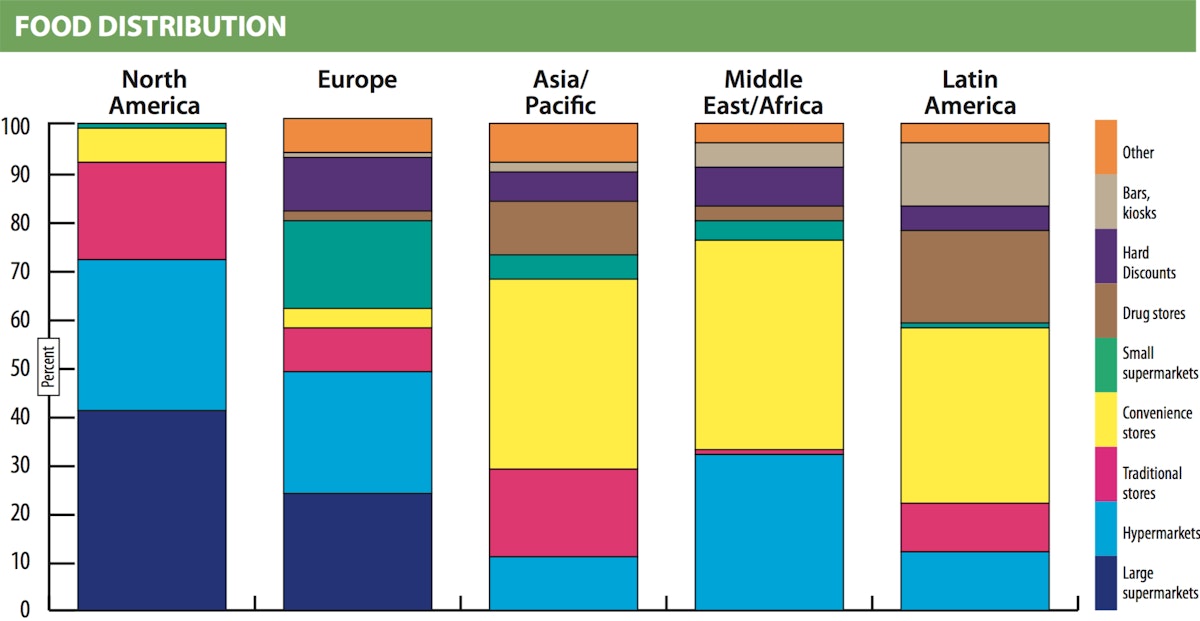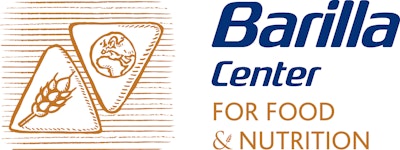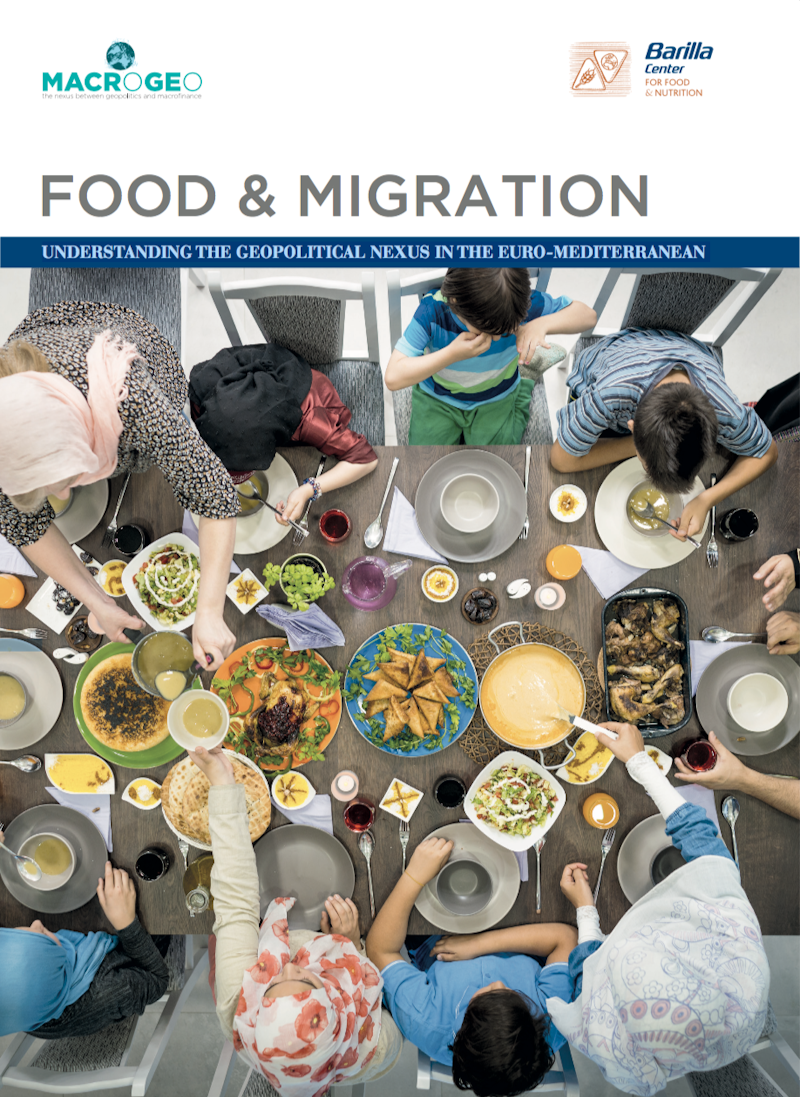Challenges of food integration in Europe
The rising consumption of ethnic food in the main EU countries can provide a glance of the change which will be provided by migration trends analyzed during the previous sections. As a powerful cultural signifier, food is crucial for the identity of communities. Europe is facing a nutritional transition whose economic, cultural and social repercussion require a comprehensive investment on education, particularly regarding second generations of migrants.
Trends on ethnic food in main EU countries
By comparing the population numbers with the supply basins of food commodities, it can be noticed that food distribution of the nine major markets in Western Europe (UK, France, Germany, Italy, Spain, Belgium, Netherlands, Austria and Portugal) amounted to € 427 billion in 2016, an increase of € 4.3 billion for consumer products, up 0.9% from 2015. In the countries of our interest, the total volume of the market today amounts to about € 321 billion: Germany 121, France 100, Italy 57 and Spain, € 43 billion 1. In these markets, the “ethnic” 2 share for household food amounts to about € 3 billion.

Matching migratory reality with aspirations and structural needs by harmonizing and enhancing the cultural and social background is a nodal challenge for the future of European societies and institutions. For this reason, it is crucial to evaluate the eating habits of migrant communities and how migratory flows are enriching our markets (and what types of markets in particular) with new foods. Moreover, the understanding of how such process affects healthcare systems is of particular interest. The first question to ask is therefore whether the demand for ethnic food (as ingredients and as food) is increasing in Europe. It can be anticipated that the answer is affirmative.
Within this perspective, the “migration-food issue” is affected by several different factors:
(A)
the age, cultural and social level, gender, religion etc. of the immigrant population;
(B)
the activity of large distribution chains on particular products that may be connected to the food culture of a given country and the cost of imported raw materials;
(C)
current migratory laws and regulations.
Worldwide, the market has grown significantly from € 26.1 billion worldwide in 2014 to € 31.52 billion, according to the Ibis World Market Report3, at the end of 2017.
To have a comparative dimension we can take the case of the United States: here the ethnic household food market reaches a business volume of € 10.5 billion. Push and support for a cross-border market comes from the constant search for new flavors by chefs, food producers and indigenous consumers, which will ensure, for example, the continued growth of the spice and herbs market, up to € 8.74 billion in 2020 with a growth rate of 5% year on year.
The figure above represents EU imports of spices and herbs from developing countries (CBI 2017).But how different are national markets and which is the composition of the demand within ethnic communities? Different communities - that naturally vary widely from country to country – face different problems. For example, in Western Europe significant differences are reflected in the food market: a. United Kingdom (Indians, Pakistani and Bengali communities / 87% supplied by the Mass Market Retail); b. The Netherlands (Indonesian, Turkish and Moroccan communities / 53% supplied by MMR); c. Germany (Turkish community / 47% supplied by MMR); d. France (Moroccan, Algerian, other North African communities and French-speaking countries of West Africa / 69% supplied from MMR) 4.

Ethnic food tastes vary from region, country and even buyer. Indian food in the UK tastes different from that in Germany and uses different ingredients and mixtures. For immigrants, finding ingredients to prepare traditional dishes is still the biggest obstacle to overcome. The progressive global urbanization and the consequent large-scale distribution of large-scale circuits have lowered the cost of ethnic products, facilitating the task of millions of migrants. At same time, it favors products that meet the taste of Europeans.
As can be seen from the figure above, the global composition of food distribution is heterogeneous. While hypermarkets, large supermarkets and grocery stores account for 93% of North American purchases, they play a much smaller role in Europe (55%), Latin America (46%), the Middle East and Africa (38%) and Asia (36 %); furthermore, in Europe and Latin America small supermarkets account for almost 20% of sales. It is hard to say whether these small supermarkets, as well as traditional forms of commerce, will retain their market share. Ethnic food is often a specialized area; therefore, larger chains find that it is not useful to compete with smaller companies that have a better cultural understanding (FAO 2017b). However, there is room for diversified and probably specialized distribution patterns, given the emergence of (a) e-commerce distributors focusing on the last mile of the distribution system; (b) increasing demand for ethnic, ethical and ecological food.
The interaction of food, health and culture
For anthropologist Claude Lévi-Strauss, men’s relationship with food is analogous to their relationship with language. Both relationships occur naturally and culturally at the same time. Each ethnic group defines its identity 5 in relation to the foods that make up its primary food base (in Mediterranean cultures, for example, wheat products), but also in relation to special foods that celebrate social relationships in ritual mode or are part of religious precepts. In Mediterranean history, oil and lard consumption was a result of the interaction between production specialization and religion as a prescriber of food habits (González Turmo 2012).
Food, therefore, is a powerful cultural signifier. Through it, we can manifest inclusiveness, belonging, attachment, in short being a symbolic expression of social bond. On the contrary, it can represent exclusivity, generate stereotypes and feelings of disgust that demarcate boundaries.
Today, ethnic minorities are a significant and growing part of the population in European countries. Immigrants from low-income countries represent an increasing share of the population in Europe, set to increase further over time, given the future scenarios and demographic trends. Among the social changes and changes in eating habits we are witnessing a kind of nutritional transition: on the one hand, the adoption of local food culture by migrants; on the other hand, the integration of migrants’ food habits by the overall population, generating new dietary models (on the Mediterranean diet, see BCFN 2016b).
Within this framework, the health status 6 of many ethnic minorities is worth studying, both in the comparison to the indigenous population and in the comparison to different groups of ethnic minorities (see Ottesen, Wandal, 2012; Vandenheede H. et al. 2012 on diabetes). An example comes from a study based on data from a French national survey (Wenner et al. 1995) which compared food habits of three groups of migrants from Maghreb to Italy, Spain and Portugal with those of French nationals. The study found a lower consumption of meat and dairy products among migrants and their higher consumption of starchy foods and dried vegetables. The authors concluded that immigrants had a weaker perception of preventive messages. More recent studies emphasize differences in food consumption between migrant communities in Europe and their compatriots in countries of origin. A study on Ghanaian, for example, found significant differences between food preferences in rural Ghana (starchy foods), urban Ghana (animal-based products) and in Europe (a highly diverse diet) (Galbete C. et al. 2017).
More generally, food transition studies have highlighted a process of change in immigrant groups. It generally begins with the replacement of rice with bread, meat and then baking methods. At a later stage of the transition, there is the shift from whole milk to skim milk and an increase in coffee consumption. The process closes with the adoption of baked bread, breakfast cereals, salads and fruit. In addition, fast food and prepared meals are picked up, beginning with breakfast and meals eaten outside the home, while the main meal is the last to change. Although the distinction between Western and traditional diet models is not always clear, the main dietary immigrant trend is a substantial increase in the consumption of fat and refined carbohydrates, resulting in low intake of fibers. Somehow, we could say they firstly develop our “food vices”. The figures also indicate an increase in the consumption of meat and dairy products. All of these dietary changes can contribute to a higher risk of obesity, with strong propensity to develop type 2 diabetes (T2D) and cardiovascular disease (CVD). A study on the prevalence of diabetes mellitus and cardiovascular disease among the Turkish and Moroccan ethnic groups in the Netherlands has reported a higher prevalence of type 2 diabetes in the Turkish (12.3%) and Moroccan groups (12.4%) compared with the Dutch indigenous population (3.0%) (Dijkshoorn et al. 2003).
Conclusion: a research agenda on food and integration
In countries of origin of migrations, high levels of food insecurity result in a greater number of migrations: according to the World Food Program (2017), every percentage point of increase in the food insecurity index forces 1.9% of the population to migrate, while a further 0.4% flee for each year of war.
Moreover, European countries have already changed due to demographic trends and flows of migrants (Collier, 2013). This represents a significant socio-cultural shift. For instance, over the last thirty years, foreigners in Italy have more than doubled. Today, representing a percentage of just under 10%, they definitively marked the transformation of Italy from land of emigration to land of economic immigration and they are certainly a factor, as in other countries, in the consumption of goods and products.
Demographic and geopolitical changes in this field have caused a series of challenges on cultural identities, integration and recognition of rights. Future trends show that the challenges ahead would be even more relevant for European societies.
European and international policies need to consider that food choices in a migratory context have many meanings. They may indicate the will to keep alive memories of experiences of the places of origin, or - on the contrary – the desire to distance from what is perceived as a fragment of the past that must be overcome. Food security should not only be considered as one of the key factors triggering ongoing migration, but it should also be analysed on migration routes and on countries of destination, based on the experience of migrants (see WFP 2017).
For those who migrate, changes in eating habits can also lead to a changes in health conditions. A growing number of mortality studies on immigrants have shown that when they consume food in a Western way, they experience higher rates of heart disease, high blood pressure, and diabetes. Very often, immigrants represent the poorest part of our societies. According to US studies (Singh, Miller 2004) where the migratory tradition is longer, this “poverty trap” has repercussions on the second generation. In fact, children of migrants born in countries of destination may have a higher standard of living but a lower life expectancy than their parents.
This seems paradoxical to the idea that moving from developing to developed countries improves every aspect of life. For this reason, food education - important to all citizens, but above all to second generations of migrants – also plays a central role in the prevention of obesity and many chronic-degenerative diseases. And to be effective, this comprehensive education approach has to be in early childhood, to prevent bad eating habits and lay the foundations for future well-being.
Almost two thousand years ago, the Roman philosopher Seneca, exiled in Corsica, wrote to his mother Elvia: “Different people have been led away from their homes by different causes; but in all cases it is clear that nothing remains in the same place in which it was born: the movement of the human race is perpetual: in this vast world some changes take place daily” 7.
Further research on food and migration in the wider Mediterranean is a crucial interest for all countries involved, given the geopolitical and demographic challenges we are facing. This will be nourished by a proper consideration of the role of food in culture and, therefore, in all integration policies. This is why, along with a series of recommendations which summarize our approach, we have collected a series of best practices on food and integration, regarding countries of origin, of transit, and of destination of migrants.
Novelist Mohsin Hamid writes in “Exit West” (2017): “We are all migrants through time”. The truth is that we are also migrants through food.
Notes
1 MacroGeo elaboration on Nielsen Strategic Planner 2016 data.
2 “In a narrow sense, ethnic foods are defined as foods originating from a heritage and culture of an ethnic group who use their knowledge of local ingredients of plants and/or animal sources. To illustrate, Hindu food from India, Maori food from New Zealand, and Masai food from Kenya are all considered ethnic foods. However, the term ethnic food is ambiguous. Thus, in a broader sense, ethnic food can be defined as an ethnic group’s or a country’s cuisine that is culturally and socially accepted by consumers outside of the respective ethnic group. For example, Greek food, Indian food, Italian food, Thai food, and Korean food are all considered ethnic food outside of their own countries. Furthermore, foods eaten by people of different religions are also considered ethnic food. For example, traditional Buddhist cuisine, Christian cuisine, and Muslim cuisine are also included in the category of ethnic food” (Kwon 2015). Given that the use of the word “ethnic” changes when the context of ethnicity changes (for example, if a subgroup becomes a majority group, or becomes incorporated into the majority cultural tradition), what may be considered “ethnic food” will undoubtedly change over time.
4 CBI 2017 and MacroGeo elaboration on Ibis world and Nielsen mass market data.
5 “…Modern-day Western metropolises are, in fact, full of “ethnic” food stores which, out of religious vocation or community spirit, allow members of a given faith to keep to precise rituals and, together with the flavors of traditional foods, maintain the knowledge of being part of a social universe with its own identity…” (BCFN 2009a).
6 On food and health, see BCFN 2009b.
7 We thank Massimo Livi Bacci for the quote, analysed further in his works, including Livi Bacci (2015). The original text is: “Alios alia causa exciuit domibus suis: illud utique manifestum est, nihil eodem loco mansisse quo genitum est. Adsiduus generis humani discursus est; cotidie aliquid in tam magno orbe mutatur” (Ad Helviam Matrem De Consolatione, VII, 5).


